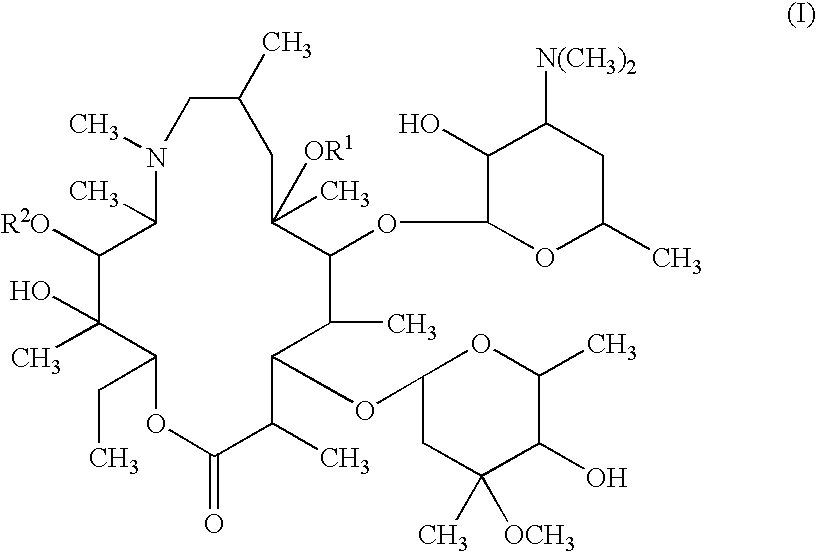Topical treatment or prevention of ocular infections
a technology for ocular infections and treatment, applied in the direction of antibacterial agents, aerosol delivery, prosthesis, etc., can solve the problems of eyelids, conjunctiva, cornea, eyelid infections, eyelid infections, etc., and achieve the effect of preventing ocular infections, challenging and/or problematic treatment of ocular infections
- Summary
- Abstract
- Description
- Claims
- Application Information
AI Technical Summary
Problems solved by technology
Method used
Image
Examples
examples 3-6
Noveon AA-1 is slowly dispersed into a beaker containing approximately 1 / 3 of the final weight of water and stirred for 1.5 hrs. with an overhead stirrer. Noveon AA-1 is an acrylic acid polymer available from B.F. Goodrich. Edetate sodium (EDTA), BAK, sodium chloride, and surfactant are then added to the polymer solution and stirred for 10 minutes after each addition. The polymer suspension is at a pH of about 3.0-3.5. The azithromycin is added and stirred to disperse for 30 minutes. The mixture is sterilized by autoclaving at 121.degree. C., for 20 minutes. Alternately, the azithromycin may be dry heat sterilized and added by aseptic powder addition after sterilization. Mannitol, and boric acid, or sodium perborate, Dequest, mannitol, and boric acid are dissolved separately in approximately 1 / 2 of the final weight of water, added to the polymer mixture by sterile filtration (0.22 .mu.m filter) and stirred for 10 minutes. The mixture is adjusted to the desired pH with 10N sodium hyd...
example 7
Noveon AA-1 is slowly dispersed into a beaked containing approximately 1 / 2 of the final weight of water and stirred for 1.5 hrs. With overhead stirrer. Noveon AA-1 is an acrylic acid polymer available from B.F. Goodrich. Edetate sodium (EDTA), Poloxamer 407, and sodium chloride are then added to the polymer suspension and stirred for 10 minutes. The polymer suspension is at a pH of about 3.0-3.5. The azithromycin is added and stirred to disperse for 30 minutes. The mixture is sterilized by autoclaving at 121.degree. C. for 20 minutes. Alternately, the azithromycin may be dry heat sterilized and added by aseptic powder addition after sterilization. Mannitol is dissolved in 1 / 10 of the final weight of water and sterile filtered (0.22 .mu.m filter) in to the polymer suspension and stirred for 10 minutes. The mixture is adjusted to desired pH with 10N sodium hydroxide while stirring, brought to final weight with water by sterile filtration and aseptically filled into unit-dose container...
example 8
An azithromycin ointment is prepared by dissolving 0.3 grams of azithromycin and 0.5 grams of chlorobutanol in a mixture containing 3.0 grams mineral oil / 96.2 grams white petrolatum by stirring in a 100 ml beaker while heating sufficiently hot to dissolve both compounds. The mixture is sterile filtered through a 0.22 .mu.m filter at a sufficient temperature to be filtered and filled aseptically into sterile ophthalmic ointment tubes.
PUM
| Property | Measurement | Unit |
|---|---|---|
| Fraction | aaaaa | aaaaa |
| Fraction | aaaaa | aaaaa |
| Fraction | aaaaa | aaaaa |
Abstract
Description
Claims
Application Information
 Login to View More
Login to View More - R&D
- Intellectual Property
- Life Sciences
- Materials
- Tech Scout
- Unparalleled Data Quality
- Higher Quality Content
- 60% Fewer Hallucinations
Browse by: Latest US Patents, China's latest patents, Technical Efficacy Thesaurus, Application Domain, Technology Topic, Popular Technical Reports.
© 2025 PatSnap. All rights reserved.Legal|Privacy policy|Modern Slavery Act Transparency Statement|Sitemap|About US| Contact US: help@patsnap.com



